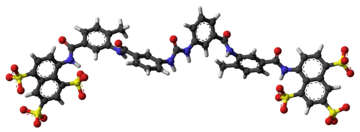 | |
 | |
| Clinical data | |
|---|---|
| Trade names | Antrypol, 309 Fourneau, Bayer 205, others |
| AHFS/Drugs.com | Drugs.com archive |
| Routes of administration | by injection only |
| ATC code | |
| Identifiers | |
| |
| CAS Number | |
| PubChem CID | |
| IUPHAR/BPS | |
| DrugBank | |
| ChemSpider | |
| UNII | |
| KEGG | |
| ChEBI | |
| ChEMBL | |
| PDB ligand | |
| CompTox Dashboard (EPA) | |
| ECHA InfoCard | 100.005.145 |
| Chemical and physical data | |
| Formula | C51H40N6O23S6 |
| Molar mass | 1297.26 g·mol−1 |
| 3D model (JSmol) | |
| |
| |
| | |
Suramin is a medication used to treat African sleeping sickness and river blindness.[1][2] It is the treatment of choice for sleeping sickness without central nervous system involvement.[3] It is given by injection into a vein.[4]
Suramin causes a fair number of side effects.[4] Common side effects include nausea, vomiting, diarrhea, headache, skin tingling, and weakness.[2] Sore palms of the hands and soles of the feet, trouble seeing, fever, and abdominal pain may also occur.[2] Severe side effects may include low blood pressure, decreased level of consciousness, kidney problems, and low blood cell levels.[4] It is unclear if it is safe when breastfeeding.[2]
Suramin was made at least as early as 1916.[5] It is on the World Health Organization's List of Essential Medicines.[6] In the United States it can be acquired from the Centers for Disease Control (CDC).[3] In regions of the world where the disease is common suramin is provided for free by the World Health Organization (WHO).[7]
- ^ "Suramin Injection Advanced Patient Information". Drugs.com. 3 January 2020. Retrieved 11 January 2020.
- ^ a b c d "Micromedex Detailed Drug Information for the Consumer: Suramin (Injection route)". PubMed Health. 1 November 2016. Archived from the original on 8 September 2017.
- ^ a b "Our Formulary Infectious Diseases Laboratories CDC". www.cdc.gov. 22 September 2016. Archived from the original on 16 December 2016. Retrieved 30 November 2016.
- ^ a b c Zuckerman JN (2002). Principles and Practice of Travel Medicine. John Wiley & Sons. p. 113. ISBN 9780471490791. Archived from the original on 30 November 2016.
- ^ Mehlhorn H (2008). Encyclopedia of Parasitology: A-M. Springer Science & Business Media. p. 475. ISBN 9783540489948. Archived from the original on 30 November 2016.
- ^ World Health Organization (2019). World Health Organization model list of essential medicines: 21st list 2019. Geneva: World Health Organization. hdl:10665/325771. WHO/MVP/EMP/IAU/2019.06. License: CC BY-NC-SA 3.0 IGO.
- ^ "Trypanosomiasis, human African (sleeping sickness)". World Health Organization. February 2016. Archived from the original on 4 December 2016. Retrieved 7 December 2016.